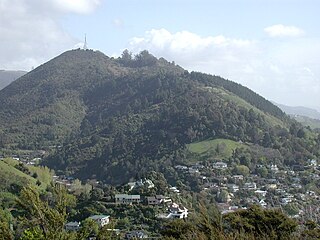
Nelson is a New Zealand city on the eastern shores of Tasman Bay at the top of the South Island. It is the oldest city in the South Island and the second-oldest settled city in New Zealand; it was established in 1841 and became a city by royal charter in 1858.
Nelson College is the oldest state secondary school in New Zealand, a feat achieved in part thanks to its original inception as a private school. It is an all-boys school in the City of Nelson that teaches from years 9 to 13. In addition, it runs a private preparatory school for year 7 and 8 boys. The school also has places for boarders, who live in two boarding houses adjacent to the main school buildings on the same campus.

Kerikeri is the largest town in Northland, New Zealand. It is a tourist destination 240 kilometres (150 mi) north of Auckland and 80 kilometres (50 mi) north of Northland's only city, Whangārei. It is sometimes called the Cradle of the Nation, as it was the site of the first permanent mission station in the country, and it has some of the most historic buildings in the country.

Fairfield is a suburb of Western Sydney, in the state of New South Wales, Australia. Being in the centre of the Cumberland Plain, Fairfield is located 30 kilometres (19 mi) west of the Sydney central business district and is the administrative heart of the Fairfield City Council – despite a very small portion of it belonging to the Cumberland Council. Fairfield supports a mixture of commercial and residential developments, mostly characterised by medium-density buildings and some new high-rise apartments.

New Zealand Parliament Buildings house the New Zealand Parliament and are on a 45,000 square metre site at the northern end of Lambton Quay, Wellington. From north to south, they are the Parliamentary Library building (1899); the Edwardian neoclassical-style Parliament House (1922); the executive wing, called "The Beehive" (1977); and Bowen House. Whilst most of the individual buildings are outstanding for different reasons, the overall setting that has been achieved "has little aesthetic or architectural coherence".
Cabragh House is a late Victorian, timber house at 48 Weka Street in Nelson, New Zealand built circa 1897. It is a historic site for exemplarising late Victorian furnishings and provincial New Zealand vernacular architecture. The neighbouring Amber House, the former site of the Cabragh House School, is pending registration as a New Zealand Historic Place.

James Crowe Richmond was a New Zealand politician, engineer, and an early painter in watercolours of the New Zealand landscape.

The Boulder Bank is a very unusual naturally formed landform in Nelson, New Zealand. It is a 13 kilometre long stretch of rocky substrate which begins at the Mackay Bluff and ends at the Cut of the Nelson Harbour. Haulashore Island was once a part of the Boulder Bank, but the Cut made it an island, and it is no longer connected to the Boulder Bank. The Boulder Bank separates Tasman Bay and the Nelson Haven and is managed as a scenic reserve by the Department of Conservation. Land access is gained along Boulder Bank Drive, signposted at the northern end of Nelson Haven on State Highway 6.

The Nelson Provincial Museum, Pupuri Taonga O Te Tai Ao is a regional museum in the city of Nelson, New Zealand. The museum showcases the Nelson and Tasman regions' history, from geological origins to the stories of individuals and families.

Arthur Samuel Atkinson was a 19th-century Member of Parliament from the Taranaki Region, New Zealand.
Jane Maria Atkinson was a New Zealand pioneer, writer, and the first Pākehā woman to climb Mount Taranaki.

The Rutherford Hotel is a luxury accommodation hotel in Nelson, New Zealand. It is the biggest hotel in Nelson and the city's tallest building. It is part of the chain company Heritage Hotels, which have hotels based in many locations around New Zealand.

Pepin Island is a privately owned tied island in New Zealand connected by a causeway to the settlement of Cable Bay, north-east of Nelson.

Stafford Place at 61 Redwood Road, Appleby, New Zealand, is registered with the New Zealand Historic Places Trust as a Category I structure.

Founders Heritage Park is a museum in Nelson, New Zealand, housing a number of groups with historical themes, including transport. A short heritage railway line is operated by the Nelson Railway Society. Several shops operate in the museum, selling bakery and other artisan foods, as well as locally-made arts & crafts.

The Brook is one of the suburbs of Nelson, New Zealand. It lies to the south of Nelson and is the location of the Brook Waimarama Sanctuary, a conservation project at the head of the Brook Valley.

Melrose House in 26 Brougham Street, Nelson, New Zealand, is registered with Heritage New Zealand as a category I structure with registration number 259. It was built for Charles Fowell Willet Watts (1823–1881), one of Nelson's earliest settlers.
Ruth Atkinson was a New Zealand activist who was involved in the Temperance movement and women's rights movement. From 1910 until her death was the president of the Women's Christian Temperance Union of New Zealand branch in Nelson. In 1919, she was chosen by the organization to participate in the Inter-Allied Women's Conference, a parallel conference to the 1919 Paris Peace Conference.

Māngungu Mission was the second mission station established in New Zealand by the Wesleyan Missionary Society. Located near Horeke, in the Hokianga harbour, it was founded in 1828 by the missionaries John Hobbs and James Stack after the first WMS mission station in the country had been sacked the previous year. Māngungu Mission was abandoned in 1855 when Hobbs, the sole missionary at the site, relocated to Auckland. The residence that Hobbs built and lived in at the mission has been preserved by Heritage New Zealand and is now a museum.















